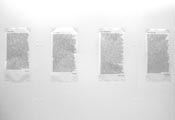


-> Èmilie du Châtelet
-> Ada Lovelace
-> Sofja Kovalewskaja
-> Blanche Wittmann
| -> ARTWORKS |
il libro delle scienziate
dimenticate
the book of forgotten
scientists
exibition, atrium
turin 2006
 |
 |
 |
-> Èmilie du Châtelet |
click on image to enlarge |
Claudia Mongini, working between science and art, tells a story that is secret but at the same time known by everybody: the often contested female presence in the sphere of modern science. In times in which women were still banned from academies, many were the personalities who were able to break the blockage imposed by culture, religion and society, and to enrich scientific research with important discoveries. The book of forgotten scientists throws, page after page, a light on peculiar and innovative lives. It is the case of Ada Lovelace, Byron´s daughter, who conceived the computer in times in which the machine was not yet realizable, or of Sofja Kovalevskaja, friend of Dostoevskij and Weierstrass, one of the first female mathematics professors who, beneath her scientific activity, always found time to dedicate to the cause of the freedom of thought and to narrative writing. Blanche Wittmann then - whom the Swedish author Per Olov Enquist dedicated a spendid novel, The book about Blanche and Marie – was for long time a “professional hysteric” in the demonstrations held in the parisian clinique directed by Charcot, before becoming Marie Curie´s assistant and sacrificing her body for radium research. Atrium shows a glimpse into a fascinating world, a lost atlas of ideas, introduced by the science journalist and writer Stefania Maurizi. Luca Scarlini
|
Female biographies sunken in oblivion, scientific treatises and innovative experiments left in shadow: how is it possible to approach such a theme, fragmented on one side, but also extremely complex if we consider all its multiple aspects? What is the role that art can assume on its behalf? The book here in question is not intended as a linear sequence of facts and events; i chose, instead, to conceive of it as a sort of diagram, that bifurcates starting from fragments relative to four protagonists of scientific culture and almost ignored by the collective imaginary. (Beyond the three women already quoted by Scarlini, i consider Èmilie du Chatelet, whose french translation of Newton´s Principia Mathematica is, till now, the only one existing). My concern goes to singular aspects, like the letters that Sofja Kovalevskaja wrote to Weierstrass, burned by him after her death, in order not to create suspicions of a sentimental relationship that never happened, or Lovelace´s interpretation of Babbage´s machine. Aspects that i want to re-propose in aesthetic terms, materialized in the form of an “artistic” product; an attempt to reconstruct a complex of sensations that might invite us to read the scientific historiography from another point of view. Claudia Mongini
|